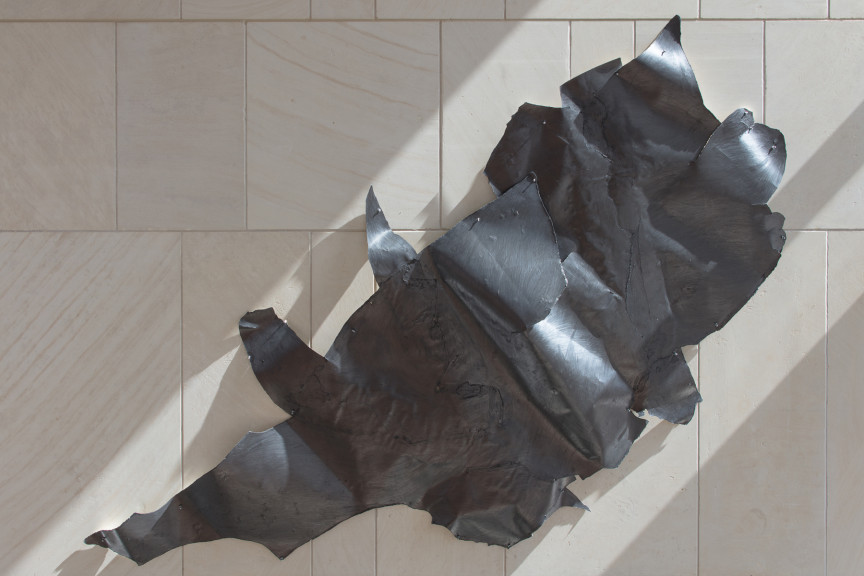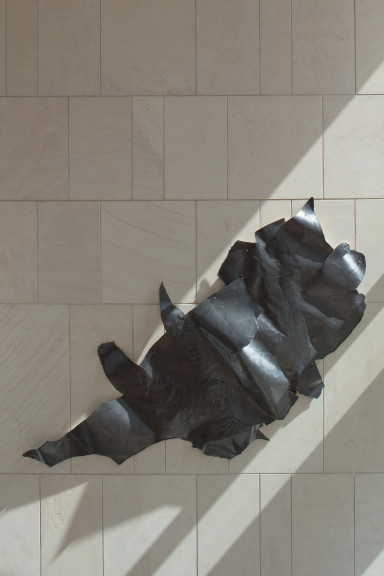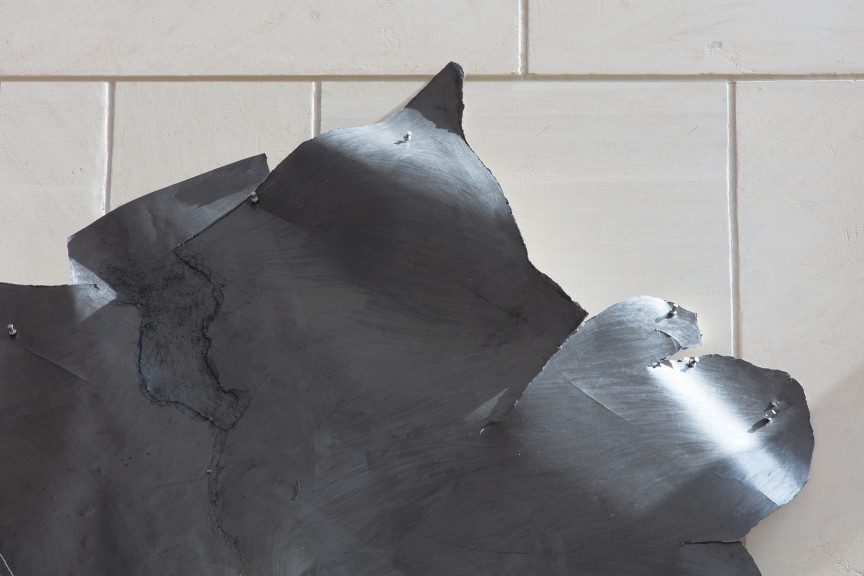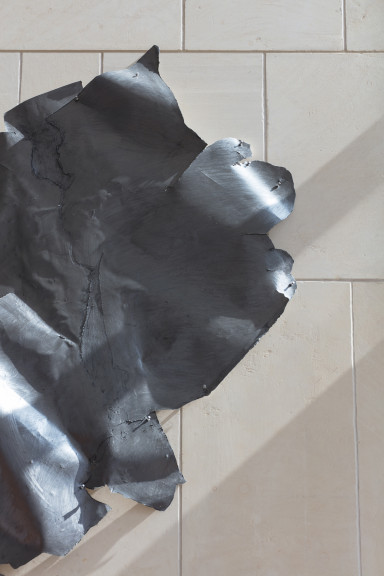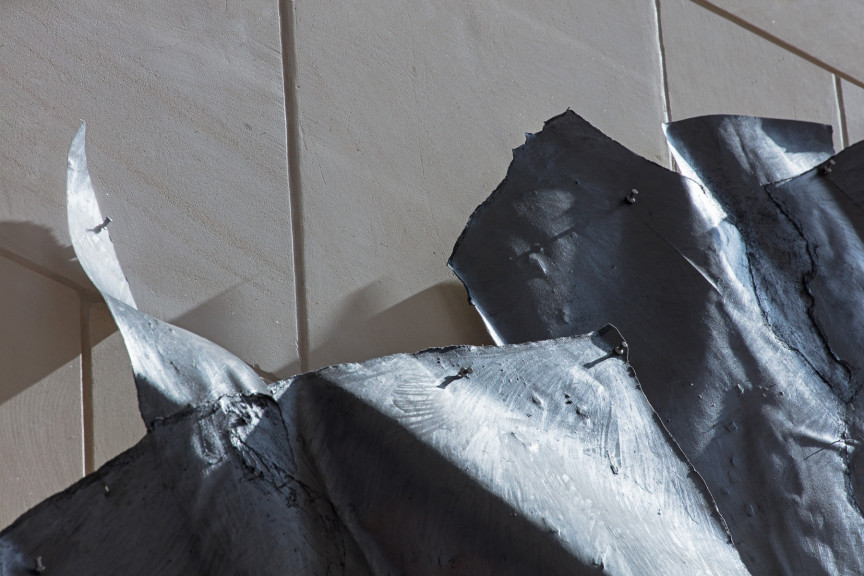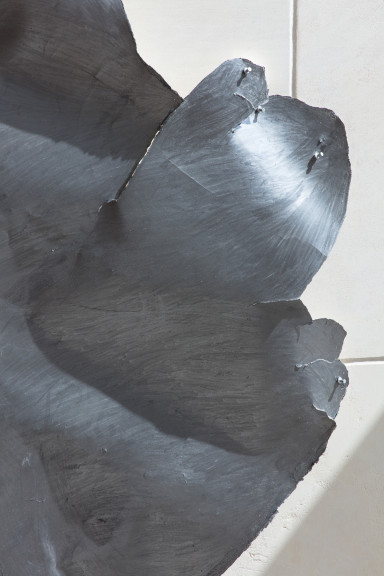Drawing
Nancy Rubins
81 x 132 x 23 inches
Purchase, Landmarks, The University of Texas at Austin, 2016
GPS: 30.287783, -97.737455
A sculptor who salvages the unlikeliest of everyday objects, and also a draftsman who uses paper and graphite as sculptural materials, Nancy Rubins is well practiced in upending tradition. Her works that are labeled “drawings” share the physical presence and spatial dynamism of sculptures in the round. Drawing is lustrous and dark, absorbing and deflecting light in a way that complicates its contours.
Early on, Rubins explored ways of transgressing boundaries between mediums. Drawing and Sawhorse (1975) featured a large sheet of paper, thoroughly covered in graphite and draped over a sawhorse to suggest an animated form; two protruding sawhorse legs made it look vaguely bovine, as did a boxy, headlike extension of the graphite-covered paper. In Drawing (1974), a penciled sheet of paper was simply slung over a length of heavy rope as if it were laundry on a clothesline.
These and other early hybrids of sculpture and drawing introduced a way of using paper to which Rubins would return. Generally attached directly to the wall—sometimes spanning corners and occasionally also pinned to the ceiling, or allowed to spill onto the floor—these fully three-dimensional works are robust survivors of a working process that leaves them battered, gouged, and ripped; pinned and re-pinned; and, above all, covered side to side and top to bottom in furiously drawn strokes of dark, glistening graphite. The resulting rough-edged configurations, gathered into folds, resemble sheets of gleaming lead. As with the early drawings on sawhorses, these later works on paper sometimes assume a vaguely figurative aspect. Even more primordial are the associations invoked by the graphite, which lends a mineral glint to the surfaces of the drawings and a sense of seismic collision to the constituent sheets’ abutted edges.
Rubins uses pencil to engage light in a way that makes her drawings’ surfaces expand; the illusion they create is of exaggerated size, not weight. Nor do they conform to the rectangular shape of a conventional sheet of paper: they are not discrete objects—they cannot be framed; they are not, in any ordinary way, images.
ACTIVITY GUIDES

Drawing
Nancy Rubins
Subject: 3-dimensional shapes
Activity: Foil Drawings
Materials: Cardboard or mat board, cardboard or mat board scraps cut into strips and shapes, glue, brush, aluminum foil, tape
Vocabulary: Collage, texture, layer
The artist who made this drawing is a sculptor who is used to working with large metal objects. She made the sculpture with canoes outside of this building. Even though this is a drawing, she wanted it to look like sheets of metal. To do this she took graphite, the material in pencils, and drew all over thick sheets of paper until they were completely covered. Then she hung them on a wall to let the edges curl and fold just like sheets of metal.
If these were sheets of metal, what could you make out of them?
Can you see the texture the artist made by drawing in different directions?
Even though it is one solid color you can see shapes and lines all across the drawing.
-
Create a collage by gluing strips and shapes of cardboard onto a large piece of cardboard. Glue shapes on top of one another to create a relief.
-
Squeeze a small amount of glue on one side of a piece of aluminum foil the same size as your picture. Use a brush to spread it around.
-
Before the glue dries place the piece of aluminum foil over the top of your collage. Using your fingers gently press into the shapes of the collage behind it until you see the details through the aluminum foil.
Collage - The supplies artists use to make a work of art. Paint, chalk, wood, and stone are all materials.
Texture - The area in and around a sculpture.
Layer - Placing one shape on top of another.

Drawing
Nancy Rubins
Subject: Pattern and texture
Activity: Pattern Drawing
Materials: Paper; pencil, markers or crayons; colored construction paper
Vocabulary: Graphite, pattern
The artist who made this drawing, Nancy Rubins, also made the sculpture with canoes outside. Usually, when we see drawings by famous artists they are framed and hung on a wall in a museum. Rubins likes her drawings to take up space just like her sculptures. To do this she takes heavy sheets of paper and with a thick piece of graphite covers the sheet with marks. She presses hard with the graphite and draws in one direction across the entire sheet. Then she changes direction and adds another layer. She does this over and over again, making the sheet curl up in unusual ways. By pinning the drawing on the wall she lets the curls and folds show.
How are the two works of art by Nancy Rubins similar? How are they different?
How would the drawing change if it were pressed flat and displayed in a frame?
How would the drawing change if Rubins used a colored pastel or marker?
-
With a crayon, marker, or colored pencil, draw a simple shape at the corner of a sheet of paper. It can have sharp corners or rounded edges.
-
Draw a line around the shape. Try to get close to but do not touch the rst shape.
-
Continue the drawing by building another line around the second line and watch the shape get bigger and bigger. If the shape gets too big, start another one on a different spot. Fill the entire sheet with repeating shapes and lines. The sheet should start curling and crease like the Rubins’ drawing. Download this activity guide to see an example.
Nancy Rubins likes to hang her drawings on the wall without a frame like a piece of sculpture.
Can you see the textures in Rubins’ drawings, which were made by rubbing the graphite on the paper in different directions?
Graphite - A natural material that can be formed into thick sticks and used for drawing. Graphite is the material in a pencil.
Pattern - A repeating line, shape, or color.

Drawing
Nancy Rubins
Subject: Close looking
Activity: Art Battle: Drawing vs. Sculpture
Materials: Pencil or pen and paper
Vocabulary: Found objects, 3-dimensional, graphite
Nancy Rubins is known primarily for sculpting large works of art like Monochrome for Austin, located outside this building. Even her drawings look like sculpture because they take up 3-dimensional space rather than resting at against a wall. Rubins uses found objects like canoes and airplane parts to create her sculptures because she likes the rough look of large sheets of metal. So it’s no surprise that her drawings look like sheets of metal too.
Rubins’ drawings are made by rubbing graphite in all different directions across a thick piece of paper. There are so many layers of graphite that the paper starts to resemble metal, even curling and buckling from the pressure she applies when pressing the graphite to the paper.
How is this drawing different from others you’ve seen at a museum?
Does a drawing have to go in a frame and sit at against a wall?
What are some other creative ways to make and hang or display a drawing?
Look closely at Monochrome for Austin and Drawing and think about the statements below. Look at the statements below for each work of art. Rate them from 1 (No, I do not agree!) to 5 (Yes, I agree!).
- The artist used materials in an interesting way.
- The art looks sturdy, strong, and well made.
- The art would look better in a different location; like in a park for Monochrome for Austin or in a gallery for Drawing.
- The art would look better in a different color or even multicolored.
- I want to take this home with me!
Add up the points on each sheet. Which one has more points?
Do you think this makes it the better work of art? Why or why not?
Think about the statements above and try to answer “Why?” to each one.
Found objects - An everyday object like a canoe that is used to make a work of art.
3-dimensional - A term for a work of art that is not at.
Graphite - A natural material that can be formed into thick sticks and used for drawing. Graphite is the material in a pencil.
MORE INFORMATION
A sculptor who salvages the unlikeliest of everyday objects, and also a draftsman who uses paper and graphite as sculptural materials, Nancy Rubins is well practiced in upending tradition. Hoisting big, heavy things overhead, where they balance with improbable grace, she deploys a sense of mass and scale that can be compared to a performer’s perfect timing. In fact, there is a kind of physical comedy in some of her work, early examples in particular. But it has always been balanced with a literal expression of gravitas: even at its most buoyant, the sculpture’s material and emotional heft—its physical drama—is commanding. And those works that are labeled drawings share the physical presence and spatial dynamism of the sculptures in the round.
The components of Rubins’ monumental sculptural works have ranged from household appliances to airplane parts, held together by slender steel cables. As in Monochrome for Austin, also in the Landmarks collection, in which recycled aluminum canoes cluster at the end of a listing column, her sculptures combine surpassing delicacy and indomitable strength, a polarity that is the more striking when encountered outdoors. There, its fearless balancing acts can be seen in relationship to the built environment, from which it draws its sense of scale and mass. Prominent among those who have challenged conventions of public art, Rubins is distinguished for work that expands the scope of sculpture in the civic realm.
Born in Naples, Texas, in 1952, and raised in rural Tullahoma, Tennessee, Rubins attended the Maryland Institute College of Art (MICA), where she completed a BFA in 1974. While majoring in painting she also worked a great deal in clay, and was particularly impressed by the work of Robert Arneson, a visiting artist who headed the graduate ceramics program at the University of California, Davis. After graduating from MICA, Rubins entered the program at UC Davis, completing her MFA there in 1976. In a recent interview with Xandra Eden, Rubins said she relished the relatively small and quiet working environment at Davis, and, especially, “the northern California funk aesthetic, which, to me, seemed like a kind of funny and vulgar answer to Pop. I liked the earthiness and rawness of it.” Although she would never produce the figurative work favored by Arneson and others associated with California Funk, Rubins fully absorbed its insubordinate spirit.
Rubins stayed in Northern California for a few years, but by the late 1970s had been drawn to New York. There she began making spectacularly massive assemblages of domestic appliances—fans, clocks, TVs, toasters—embedded in looming walls and mushrooming towers of concrete. A teaching opportunity brought Rubins back West in 1982, when she joined the faculty at UCLA, and she has remained in southern California ever since. When she arrived at UCLA, her colleagues included the mischievous conceptual sculptor Charles Ray (who invited her), Chris Burden, then known for physically grueling performance work (Rubins later married Burden, who died in 2015), and Paul McCarthy, master of scabrous videos and installations. These associations proved instrumental, but as at Davis, Rubins maintained a vigorous independence.
Early on, Rubins explored ways of transgressing boundaries between mediums. A project of 1976 involved heavily graphite-covered paper spattered with red paint, and a small electric fan implicated in the work’s creation. Drawing and Sawhorse (1975) featured a large sheet of paper, also thoroughly covered in graphite, that was draped over a sawhorse so as to suggest an animated form; two protruding sawhorse legs made it look vaguely bovine, as did a boxy, head-like extension of the graphite-covered paper. In Drawing (1974), a penciled sheet of paper was simply slung over a length of heavy rope as if it were laundry a clothesline. These and other hybrids of sculpture and drawing introduced a way of using paper to which Rubins would return in the 1990s.
Paradoxical qualities were apparent from the start in the fully sculptural work as well. What has held it together since the mid-1980s is not the brute cohesion of concrete but steel cable held in tension, as in suspension bridges. In other words, the sculptures are bound—often in dramatically cantilevered configurations—by active relationships among parts. “I’ve often felt . . . a relationship to the work of Kenneth Snelson and Tensegrity since what I’m making is held together by tension,” Rubins recently told Flash Art, citing a sculptor of elegant geometric constructions, and a term coined by the radical designer and inventor Buckminster Fuller. Moreover, the physics that keeps these seemingly impossible concatenations of heavy objects in the air is plain to see. Talking with Xandra Eden, Rubins explained, “In my work . . . you see every twist of every wire and every hole drilled into every object, and how it attaches to the stainless steel structure—or not. Although the sculptures can appear to defy gravity and, perhaps, have a sense of energy that seems to be expanding or contracting, there is a clear and transparent view of what allows them to exist.”
These kinds of constructions had reached truly colossal proportions by the late 1980s, as in Another Kind of Growth (1988), which added a trailer home to the materials Rubins strung together. In 1992, she was represented in the much talked-about exhibition Helter Skelter, organized by Paul Schimmel at the Los Angeles Museum of Contemporary Art, with the epic sculpture Trailers & Hot Water Heaters (1992). Soon fighter jet wings and fuselages were among Rubins resources as well, lending the work associations to power as well as grace, and a kind of propulsive energy that evokes J. G. Ballard’s novels of calamitous beauty and Paul Virilio’s theorization of violence and speed. These sculptures gave way in turn to others using bound mattresses sandwiched around squashed masses of frosted cake—materials that are thoroughly domestic and yet, in their overpowering abundance and imminent spoilage, still deeply disruptive. By the middle of the following decade, Rubins had begun to assemble brightly colored fiberglass canoes and kayaks into outsize bouquets that flowered overhead with a less aggressive kind of exuberance. “The boats behave beautifully in the air,” Rubins observed with some surprise in a 2006 interview for the New York Times. Indeed, the impression that they are floating high above on currents of air places us viewers in a dreamily underwater state: we are kept alert—the canoes are, after all, big and bold, and their balance seems a little precarious—but we are also made to feel, like the boats, suspended in time and space.
Monochrome for Austin, 2015
The “Monochromes” series, comprising assemblages of unpainted aluminum canoes, began in 2010; in addition to the sculpture commissioned for UT Austin, it includes examples in Buffalo, Chicago, and Paris. By forgoing color, Rubins divorces the sculptures from painterly qualities that have in the past caused critics to compare her work to John Chamberlain’s sculptures of compressed and cut-up auto parts, which have been linked in turn with the slashing compositions of Abstract Expressionism. In Rubins’ “Monochromes,” the connecting steel cables are slightly more prominent than in her previous work, forming linear networks that provide a counterpoint to the lean but substantial metal boats. In these darkly gleaming sculptures, the cantilevered, gravity-defying forms, like the playground animals in “Our Friend Fluid Metal” (2014), seem a little melancholy, and a little menacing. There is once more an association to warplanes, again nearly subliminal; some of the canoes were made by the Grumman Corporation, a major military supplier that produced the jet planes Rubins used earlier. But these vessels also evoke a different kind of movement and life: in contrast to the thundering flight of old military aircraft, canoes glide silently through the water, and speak of a kind of virtuous solitude. A single paddle is enough to guide them, and their footprints are small.
Drawing, 2007
Another link the “Monochromes” sustain is with the drawings that Rubins began making around 1990. Generally attached directly to the wall, sometimes spanning corners and occasionally also pinned to the ceiling, or allowed to spill onto the floor, these fully three-dimensional works are robust survivors of a working process that leaves them battered, gouged, and ripped; pinned and re-pinned; and, above all, covered side to side and top to bottom in furiously drawn strokes of dark glistening graphite. Rubins creates the drawings on the floor, going through quantities of rectangular pencils, sharpened with utility knives, and sheet after sheet of heavy stock. Variously pleating, scoring, and abrading the paper so that it catches subsequent pencil strokes with scabby, matte depth, she attacks these surfaces to within an inch of their lives. The resulting rough-edged configurations, gathered into folds, resemble sheets of gleaming lead. As with the early drawings on sawhorses, these later works on paper sometimes assume a vaguely figurative aspect: analogies have been made to big raptors, soaring aloft or springing for flight—and, more than once, to the Winged Victory of Samothrace. Even more primordial are the associations invoked by the graphite, which lends a mineral glint to the surfaces of the drawings, and a sense of seismic collision to the constituent sheets’ abutted edges.
Rubins’ works on paper are not alone in straddling a boundary between sculpture and drawing. Richard Serra’s drawings, in particular, have often been cited in comparisons; both artists employ heavy paper densely covered with black pigment, and both are engaged with gravity as literal physical force and as metaphor. But their differences are significant: Serra’s preferred medium is oil stick, which creates a deep, lightless black, and his drawings seem to weigh much more than they actually do. By contrast, Rubins uses pencil to engage light in a way that makes her drawings’ surfaces expand; the illusion they create is of exaggerated size, not weight. Nor do they conform, like Serra’s, to the rectangular shape of a conventional sheet of paper: they are not discrete objects—they cannot be framed; they are not, in any ordinary way, images. Leavened by exuberance, their mood differs strongly from that of his works as well. Disassembled after exhibition, to be reconfigured for subsequent installations, Rubins’ drawings are as mercurial as Serra’s are obdurate.
Comparisons with other artists are also telling. Michelle Stuart’s early paper works, in which heavy sheets of paper are imbued with rusty earth ground into their surfaces, then hung floor-to-ceiling in draped layers, have some of the same geological references as Rubins’. El Anatsui’s glittering tapestries of woven bottle caps, are, like Rubins’ drawings, reconfigured each time they are hung. Both these artists share with Rubins an easy disregard for distinctions between two- and three-dimensional work.
Like all her drawings, the untitled example of 2007 in the collection of The University of Texas at Austin is lustrous and dark, absorbing and deflecting light in a way that complicates its contours. Its jagged edges point vigorously up and out, like sharp metallic teeth, although the drawing’s profile is also suggestively animated; its several constituent sheets gather to form a deeply shadowed area at its heart.
Knifing through the air with similarly vivid grace, “Monochromes” like the one on the UT Austin campus are more inward in character than preceding sculptures. Most of the decommissioned objects in Rubins’ sculptures involve action and energy, and, as always, that energy—potent if less noisy than in some cases—is latent in the “Monochromes.” But it is now a little restless, like a spirit hovering between object and image, presence and memory. At once massive and ghostly, the Monochrome for Austin has something of the grandeur and authority of traditional monumental sculptures, with their invocation of ancestral figures and shared references. And it also has the wily aspect of a half-remembered but cherished personal object that successfully eludes capture. The same mercurial nature, as of a fish flashing below the surface of water, can be seen in Rubins’ drawing. Escaping easy definition, it gains the advantage of perpetually renewable surprise.
Nancy Princenthal is a New York–based art critic and former senior editor of Art in America. She has written and lectured extensively on leading women artists such as Agnes Martin, Petah Coyne, Hannah Wilke, and Nancy Rubins. Princenthal is co-author of After the Revolution: Women Who Transformed Contemporary Art (2007) and The Reckoning: Women Artists of the New Millennium (2013). She is currently on faculty at the School of Visual Arts, New York.
Finkel, Jori, “A Bouquet of Boats Blooming at Lincoln Center,” The New York Times, 25 June 2006, AR 30.
Hamer, Katy Diamond, “New York Tales . . . Nancy Rubins,” Flash Art, 28 July 2014.
"In Conversation: Nancy Rubins and Eric Shiner," Gagosian Gallery, 9 August 2021. https://gagosian.com/quarterly/2021/08/09/video-interview-nancy-rubins-and-eric-shiner/
“Interview, Nancy Rubins and Xandra Eden,” in Nancy Rubins: Drawing Sculptures Studies (Greensboro: Weatherspoon Art Museum; Munich and New York: Prestel, 2014), 123.
Nancy Rubins. Introduction by Hugh Davies, essays by Kathryn Kanjo and Lisa Liebmann (San Diego: Museum of Contemporary Art, 1995).
Nancy Rubins: Work. Essays by Céline Flécheux and Dave Hickey (Göttingen: Steidl, 2012).
Drawing by Nancy Rubins was purchased for the interior of the Norman Hackerman Building adjacent to her assemblage Monochrome for Austin. The presentation of these two works contrast Rubins' varying themes, media and scale.
Funding for Drawing was provided by the capital improvement project for the Norman Hackerman Building. Landmarks would like to thank:
Leadership
Andrée Bober and Landmarks
Pat Clubb and University Operations
Douglas Dempster and the College of Fine Arts
Gregory Fenves and the Office of the President
Linde Hicke and the College of Natural Sciences
Landmarks Advisory Committee
David Rea and the Office of Campus Planning and Facilities Management
Project Team
Nisa Barger, project manager, Landmarks
Andrée Bober, curator and director, Landmarks
Gilles Heno-Coe, collections management, Landmarks
Nancy Rubins, artist
Catherine Williams and Silver Lining Art Conservation
Vault Fine Art Services
Special Thanks
Dean Anes, Gagosian
Michael Johnson, Nancy Rubins studio
Nancy Princenthal, curatorial contributor
Catherine Zinser, education, Landmarks

